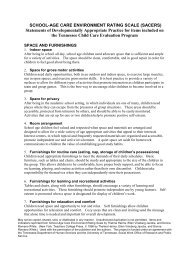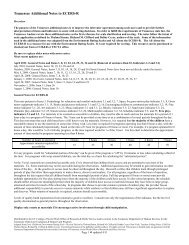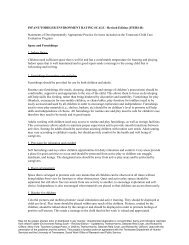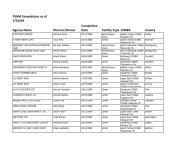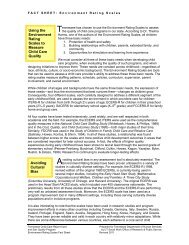Tennessee Additional Notes to ECERS-R - Star-Quality Program
Tennessee Additional Notes to ECERS-R - Star-Quality Program
Tennessee Additional Notes to ECERS-R - Star-Quality Program
You also want an ePaper? Increase the reach of your titles
YUMPU automatically turns print PDFs into web optimized ePapers that Google loves.
<strong>Tennessee</strong> <strong>Additional</strong> <strong>Notes</strong> <strong>to</strong> <strong>ECERS</strong>-R<br />
Overview<br />
The purpose of the <strong>Tennessee</strong> additional notes is <strong>to</strong> improve the interrater agreements of assessors, and <strong>to</strong> provide further interpretation of items<br />
and indica<strong>to</strong>rs <strong>to</strong> assist with scoring decisions by <strong>Tennessee</strong> Assessment <strong>Program</strong> Staff (APS). The notes were developed for use in <strong>Tennessee</strong>,<br />
but follow the intent of scale application as defined by Thelma Harms, Richard M. Clifford and Debby Cryer, authors of the scale. Some of the<br />
information used in the additional notes was adapted from the Environment Rating Scales and All About the <strong>ECERS</strong>-R. The additional notes<br />
provided for the <strong>ECERS</strong>-R scale clarify information <strong>to</strong> help in accurate scoring. The All About the <strong>ECERS</strong>-R is a resource for use with the<br />
Environment Rating Scales. It is not required for scoring. This resource can be purchased or checked out from a CCR&R or TECTA office.<br />
Be sure <strong>to</strong> replace older notes with newer notes.<br />
Most recent updates are:<br />
Oc<strong>to</strong>ber, 2009: General <strong>Notes</strong>, Items 7, 8, 10, 14, 16, 28, 35 and 36 (Some General <strong>Notes</strong> have been moved directly under the items)<br />
May 5, 2009: General <strong>Notes</strong>, Items 7, 10, 11, 12, 15, 16, 23, 28, 29 and 31<br />
April 28, 2008: General <strong>Notes</strong>, Items 7, 8, 10, 23<br />
January 1, 2008: Overview, General <strong>Notes</strong>, Item 3,4, 8, 15, 16, 18, 20, 21, 22, 23, 24, 25, 27, 28,33, 35, 36, 37<br />
April 30, 2007: General Note, Item 7, Item 11, Item 13 and Item 23<br />
November 1, 2006: Item 11; Item 26<br />
August 1, 2006: General <strong>Notes</strong>; Item 10<br />
General <strong>Notes</strong> for <strong>ECERS</strong>-R<br />
This note pertains <strong>to</strong> Items 3, Furnishings for relaxation and comfort-indica<strong>to</strong>rs 3.1 and 3.2; 7, Space for gross mo<strong>to</strong>r play-indica<strong>to</strong>r 3.1; 8, Gross<br />
mo<strong>to</strong>r equipment-indica<strong>to</strong>r 3.1; 15, Books and pictures-indica<strong>to</strong>rs 3.1 and 5.2; 16, Encouraging children <strong>to</strong> communicate-indica<strong>to</strong>r 3.2; 19, Fine<br />
mo<strong>to</strong>r-indica<strong>to</strong>r 3.1; 20, Art-indica<strong>to</strong>r 3.1; 21, Music-indica<strong>to</strong>rs 3.1 and 5.1; 22, Blocks- indica<strong>to</strong>r 3.3; 23, Sand water-indica<strong>to</strong>r 5.3; 24,<br />
Dramatic play-indica<strong>to</strong>r 3.2; 25, Nature/science-indica<strong>to</strong>r 3.2; 26, Math/number-indica<strong>to</strong>r 3.2; 34, Schedule-indica<strong>to</strong>r 3.3; and 35, Free playindica<strong>to</strong>r<br />
3.1. For materials <strong>to</strong> be counted as accessible <strong>to</strong> children, they must be able <strong>to</strong> reach and use the materials for a period of 1 hour a day<br />
in a program of 8 hours of more. The 1 hour can be provided at one time or as a combination of several periods throughout the day. This does<br />
not mean that each child must have a full hour <strong>to</strong> use the materials. However, it is required that children have a reasonable chance <strong>to</strong> use the<br />
materials at some time if they wish. Less time is required for programs operating less than 8 hours a day, with the amount of time calculated<br />
proportionally, based on the ratio of 1 hour for programs of 8 hours or more. For example, if a program operated for 6 hours a day, this would be<br />
¾ of a full-day program, so the time required would be ¾ of the 1 hour. Use this chart <strong>to</strong> determine the approximate amount of time needed in<br />
programs operating less than 8 hours.<br />
Number of hours in operation 2 hours 3 hours 4 hours 5 hours 6 hours 7 hours<br />
Approximate minutes required for<br />
accessibility<br />
15 25 30 40 45 50<br />
For any program, credit for "substantial portion of the day" can be given if the program is "off" by 10 minutes or less when calculating a third of<br />
the time. For programs with wrap around childcare, use the <strong>to</strong>tal day as a basis for calculating the "substantial portion".<br />
At the 3 level, materials are considered accessible only if it is observed that children freely access and are permitted <strong>to</strong> use most of the materials.<br />
Example: some centers may not be opened during the observation. If the schedule indicates an additional time for access <strong>to</strong> materials, base<br />
score on teacher questions and how materials were used. At the 5 level, in order <strong>to</strong> meet SPD, there should be no significant extended periods of<br />
time where structured activities prevent access <strong>to</strong> materials. Access must be observed throughout the day.<br />
Levels of quality build expectations from minimal <strong>to</strong> good <strong>to</strong> excellent. Consider not only the requirements of the indica<strong>to</strong>r, but the<br />
level of quality documented as general practice throughout the observation.<br />
With regards <strong>to</strong> supervision, staff must be able <strong>to</strong> hear the child at all times, must be able <strong>to</strong> see the child with a quick glance, and must be able<br />
<strong>to</strong> physically respond immediately, leaving no child unattended. Special attention during high risk activities, such as eating, etc. are required <strong>to</strong><br />
adequately protect children. The ages and developmental level of the children should also be taken in<strong>to</strong> consideration during these activities <strong>to</strong><br />
determine the level of supervision needed. (TN 1/1/08)<br />
Disinfectant and/or anti-bacterial wipes do not count for sanitization purposes. Products that can be given credit as sanitizing solutions are:<br />
bleach and water solution; or a commercial product that states on the label or manufacturer’s products sheet it kills 99.9% of germs, kills HIV<br />
virus, or is an EPA registered product. All commercial products used for sanitizing must be used according <strong>to</strong> manufacturer’s instruction.<br />
The following indica<strong>to</strong>rs are connected indica<strong>to</strong>rs. When credit is not given for the first indica<strong>to</strong>r, credit cannot be given for the second<br />
indica<strong>to</strong>r: 5/5.1 & 5.2, 19/5.1 & 5.2, 22/3.1 & 3.3, 5.3 & 5.4, 24/3.1 & 3.2, 5.1 & 5.2, 25/3.1 & 3.2, 5.1 & 5.2, 26/3.1 & 3.2, 5.1 and 5.2.<br />
Distributed by the UT College of Social Work Office of Research & Public Service under contract <strong>to</strong> the <strong>Tennessee</strong> Department of Human Services for the<br />
<strong>Tennessee</strong> Child Care Evaluation & Report Card <strong>Program</strong>.<br />
Adapted from Early Childhood Environment Rating Scale—Revised Edition by Thelma Harms, Richard M. Clifford & Debby Cryer. (New York: Teachers College Press, ©2005 by<br />
Thelma Harms, Richard M. Clifford & Debby Cryer). Used with permission of the publisher and the authors. All rights reserved. This project is funded under an agreement with the<br />
<strong>Tennessee</strong> Department of Human Services and the University of <strong>Tennessee</strong>, Social Work Office of Research and Policy Services.<br />
Page 1 updated 10/09
<strong>Tennessee</strong> <strong>Additional</strong> <strong>Notes</strong> <strong>to</strong> <strong>ECERS</strong>-R<br />
Items <strong>to</strong> be omitted from TN scoring: #38, #39, #40, #41, #42, #43<br />
Specific <strong>Notes</strong> for <strong>ECERS</strong>-R<br />
1. Indoor Space<br />
7.2 Ventilation control must be in the classroom for credit <strong>to</strong> be given.<br />
3. Furnishings for relaxation and comfort<br />
3.1 The floor covering must be large enough <strong>to</strong> permit at least one child <strong>to</strong> stretch out and lounge comfortably on the area with several <strong>to</strong>ys <strong>to</strong><br />
play with.<br />
4. Room arrangement for play<br />
1.2, 3.2 If there are two staff members in the room during the observation, but only 1 staff member at other times, this should be considered in<br />
scoring the item.<br />
6. Child related display<br />
5.1 Child-created display meets the intent of the entire indica<strong>to</strong>r.<br />
7. Space for gross mo<strong>to</strong>r play<br />
For a more detailed listing of Playground Safety Hazards, refer <strong>to</strong> the <strong>Tennessee</strong> Playground Safety Sheet found at<br />
www.tnstarquality.org.<br />
When there are more than 5 minor hazards or if there are 2 serious hazards outdoors, credit cannot not be given at the one level. If<br />
there are no serious hazards and no more than 5 minor hazards credit can be given in the three level. Lack of resilient surfacing,<br />
equipment spacing, etc. may be considered as major hazards depending on the measurements and whether or not serious injury could<br />
result.<br />
1.2, 3.2 Indoor space for gross mo<strong>to</strong>r play and equipment is not held <strong>to</strong> the same standards as outside; however, safety as the<br />
primary focus should be insured. Consider the placement of equipment as well as the surface under equipment where children might<br />
fall. If indoor children’s climbing equipment is used, mats or carpet are required <strong>to</strong> be placed under the equipment if it is over 12<br />
inches in height. This is in reference <strong>to</strong> equipment specifically for climbing.<br />
3.1 To give credit, the space must be accessible daily for at least 1 hour in an 8 hour program, prorated appropriately for shorter programs (see<br />
chart in general notes).<br />
8. Gross mo<strong>to</strong>r equipment<br />
For a more detailed listing of Playground Safety Hazards, refer <strong>to</strong> the <strong>Tennessee</strong> Playground Safety Sheet found at<br />
www.tnstarquality.org.<br />
When there are more than 5 minor hazards or if there are 2 serious hazards outdoors, credit cannot not be given at the one level. If<br />
there are no serious hazards and no more than 5 minor hazards credit can be given in the three level. Lack of resilient surfacing,<br />
equipment spacing, etc. may be considered as major hazards depending on the measurements and whether or not serious injury could<br />
result.<br />
5.1 Stationary equipment that is used by several children at one time and is the only option, means that the children can use it without<br />
crowding or long waits.<br />
5.2 This requires daily access <strong>to</strong> at least 7-9 skills; however, on days with inclement weather there should be at least 3-5 skills.<br />
10. Meals/ snacks<br />
1.2, 3.2 The intent of this indica<strong>to</strong>r is <strong>to</strong> determine whether the correct components of a meal or snack are being served <strong>to</strong> children. No<br />
analysis of the nutritional value of foods is necessary. Use the Food Guide <strong>to</strong> determine whether the components are present. The guidelines<br />
also require ALL components be served <strong>to</strong>gether. Personal dietary preferences of the assessor (e.g., whole grain vs. white breads; fresh vs.<br />
canned vegetables, high vs. low sugar or fat content, etc.) are not <strong>to</strong> be used in determining the quality of foods served. Foods that are<br />
Distributed by the UT College of Social Work Office of Research & Public Service under contract <strong>to</strong> the <strong>Tennessee</strong> Department of Human Services for the<br />
<strong>Tennessee</strong> Child Care Evaluation & Report Card <strong>Program</strong>.<br />
Adapted from Early Childhood Environment Rating Scale—Revised Edition by Thelma Harms, Richard M. Clifford & Debby Cryer. (New York: Teachers College Press, ©2005 by<br />
Thelma Harms, Richard M. Clifford & Debby Cryer). Used with permission of the publisher and the authors. All rights reserved. This project is funded under an agreement with the<br />
<strong>Tennessee</strong> Department of Human Services and the University of <strong>Tennessee</strong>, Social Work Office of Research and Policy Services.<br />
Page 2 updated 10/09
<strong>Tennessee</strong> <strong>Additional</strong> <strong>Notes</strong> <strong>to</strong> <strong>ECERS</strong>-R<br />
perishable should not be left out longer than 1 hour. Regardless of source or ages served, 75% of all children must receive meals and snacks that<br />
meet USDA guidelines. Providers may supplement if they choose in order <strong>to</strong> guarantee 75% compliance. <strong>Program</strong>s that choose <strong>to</strong> “offer”<br />
rather than “serve” food (i.e. family style serving, school-age multiple choice snacks) carry an additional responsibility <strong>to</strong> encourage appropriate<br />
choices and model good nutritional habits. Combination foods are foods with multiple components that have been packaged <strong>to</strong>gether or<br />
combined during the cooking process. Combination foods can be counted <strong>to</strong> meet up <strong>to</strong> two different components. Scoring consideration<br />
of combination foods should be balanced with other items on the menu. Foods that might be served <strong>to</strong>gether, but do not meet the<br />
definition of combination foods can count for up <strong>to</strong> 3 components (i.e. hamburgers, sandwiches, cereal and fruit). When vegetable<br />
garnishes are served in sufficient quantities, they may be considered <strong>to</strong> meet the requirement as a vegetable. Breading on meat products<br />
may not be counted. Beans can count as either a vegetable or protein as needed.<br />
1.3, 3.3 Eating surfaces must be cleaned and sanitized prior <strong>to</strong>, and following, use for food service. Follow the “2-step” process. Eating<br />
surfaces should be: 1) washed with a soap and water mixture <strong>to</strong> remove gross soil and, 2) sanitized with a bleach-water solution before and after<br />
being used for meals/snacks. To allow bleach-water solution <strong>to</strong> do its job, it should be allowed <strong>to</strong> sit for at least 10 seconds (preferably longer)<br />
before wiping dry or allowing <strong>to</strong> air dry. For other acceptable sanitizing agents, refer <strong>to</strong> the general notes. If proper sanitary measures are<br />
clearly practiced as part of the child care program, but an occasional lapse does occur, credit can be given. Occasional lapse for children equates<br />
<strong>to</strong> 75% of the time. To score adult handwashing, the lapse equates <strong>to</strong> the impact it has or is going <strong>to</strong> have on the children. In the case where<br />
snack time is flexible and children come and go throughout a period of time, the same sanitary conditions are required (i.e., table sanitized<br />
between children using same places, children’s hands washed, etc.). If children finger feed themselves during meals, then children should have<br />
hands washed after eating. Recontamination of hands is addressed here. To allow staff <strong>to</strong> keep their focus on children while they are eating, a<br />
separate wipe may be used on each child’s hands that have finished eating and may leave the table. When the last child has finished eating, all<br />
children should be expected <strong>to</strong> wash hands (except children without head control). Hands must be washed with soap and running water at least<br />
75% of the time.<br />
3.5 The list of food allergies does not have <strong>to</strong> be publicly displayed; however, directions for finding this information should be publicly<br />
displayed in the room where children eat.<br />
11. Nap<br />
3.2 Two coverings are required for children over 12 months of age - One <strong>to</strong> cover the type of bedding used and one for the child <strong>to</strong> have<br />
access <strong>to</strong> in order <strong>to</strong> cover up with. Bedding should be washed weekly. With the exception of cots, sleeping provisions should be 2 inches<br />
thick.<br />
12. Toileting/ diapering<br />
For proper sanitary diaper change procedure, refer <strong>to</strong> the TN 10-Step Diapering Process.<br />
3.4 Diapers should be visually checked approximately every 2 hours.<br />
13. Health Practices<br />
3.1 While combining all categories <strong>to</strong> determine 75%, priority should be given <strong>to</strong> handwashing when dealing with bodily fluids (blood and<br />
mucous). Consider the impact upon the children.<br />
14. Safety Practices<br />
For a more detailed listing of Playground Safety Hazards, refer <strong>to</strong> the <strong>Tennessee</strong> Playground Safety Sheet found at<br />
www.tnstarquality.org.<br />
When there are more than 5 minor hazards or if there are 2 serious hazards outdoors, credit cannot not be given at the one level. If<br />
there are no serious hazards and no more than 5 minor hazards credit can be given in the three level. Lack of resilient surfacing,<br />
equipment spacing, etc. may be considered as major hazards depending on the measurements and whether or not serious injury could<br />
result.<br />
1.1, 3.1 Indoor space for gross mo<strong>to</strong>r play and equipment is not held <strong>to</strong> the same standards as outside; however, safety as the<br />
primary focus should be insured. Consider the placement of equipment as well as the surface under equipment where children might<br />
fall. If indoor children’s climbing equipment is used, mats or carpet are required <strong>to</strong> be placed under the equipment if it is over 12<br />
inches in height. This is in reference <strong>to</strong> equipment specifically for climbing.<br />
15. Books and Pictures<br />
5.2 Some is defined, as being used daily and that there are at least two materials in addition <strong>to</strong> books accessible daily.<br />
Distributed by the UT College of Social Work Office of Research & Public Service under contract <strong>to</strong> the <strong>Tennessee</strong> Department of Human Services for the<br />
<strong>Tennessee</strong> Child Care Evaluation & Report Card <strong>Program</strong>.<br />
Adapted from Early Childhood Environment Rating Scale—Revised Edition by Thelma Harms, Richard M. Clifford & Debby Cryer. (New York: Teachers College Press, ©2005 by<br />
Thelma Harms, Richard M. Clifford & Debby Cryer). Used with permission of the publisher and the authors. All rights reserved. This project is funded under an agreement with the<br />
<strong>Tennessee</strong> Department of Human Services and the University of <strong>Tennessee</strong>, Social Work Office of Research and Policy Services.<br />
Page 3 updated 10/09
<strong>Tennessee</strong> <strong>Additional</strong> <strong>Notes</strong> <strong>to</strong> <strong>ECERS</strong>-R<br />
5.3 Since young children cannot read, the book area should be designed for children <strong>to</strong> view books by seeing the fronts of the books. If only<br />
the spines are showing credit cannot be given.<br />
5.4 Violence in books and pictures is not appropriate for preschool children because they can’t distinguish between fantasy and reality.<br />
Discount if 25% or more of books accessible <strong>to</strong> children show violence that is graphic.<br />
5.5 Informal reading is defined as a caregiver reading <strong>to</strong> 1, 2 or a small group of children outside of a structured, organized reading time.<br />
Informal reading must be observed at least once <strong>to</strong> get credit for this indica<strong>to</strong>r.<br />
16. Encouraging children <strong>to</strong> communicate<br />
3.1 Four instances must be observed during the observation during group time and free play.<br />
3.2 There should be enough materials <strong>to</strong> encourage communication without competition and conflict due <strong>to</strong> scarcity.<br />
5.2 Required materials should be accessible for a substantial portion of the day.<br />
7.2 In order <strong>to</strong> give credit for this indica<strong>to</strong>r, some evidence must be observed. Consider the ages and abilities of the children.<br />
18. Informal use of language<br />
3.1 At least two examples of conversation must be observed during the observation.<br />
20. Art<br />
7.2 Art activities related <strong>to</strong> other classroom experiences should allow children <strong>to</strong> do art in their own ways, while considering a <strong>to</strong>pic being<br />
discussed and experienced in the class.<br />
21. Music/ movement<br />
3.3 Children must be able <strong>to</strong> do at least one movement activity at least once per week.<br />
5.2 Variety can be considered in songs sung in the classroom in addition <strong>to</strong> tapes, records, and/or CDs. All words <strong>to</strong> music that is played,<br />
sung, or chanted should be appropriate for children; discount here if it is not.<br />
22. Blocks<br />
3.2 Some means that the space, although not necessarily large, does allow the children <strong>to</strong> successfully balance, build and create structures in<br />
their block play. The space size would allow two children <strong>to</strong> build successfully without undue interference from one another or from others.<br />
5.2 Centers should be organized <strong>to</strong> encourage independent use. Interest areas should be well defined and have accessories within the block<br />
area, so that the child doesn’t have <strong>to</strong> go <strong>to</strong> other places in the room <strong>to</strong> find accessories.<br />
5.4 If two or more block areas are present, all may be considered in calculating accessibility for substantial part of the day. However, only<br />
one must meet the criteria for a special block area. The other block area may be outdoors or in another indoor space.<br />
7.3 Some block play, available outdoors means that the children have opportunities for more active block play without the space and noise<br />
restrictions associated with being indoors. A large number of blocks are not required but there should be enough blocks so children can explore,<br />
build and experiment without difficulty. The outdoor blocks do not need <strong>to</strong> accessible daily, but should be available for the teacher <strong>to</strong> add <strong>to</strong> the<br />
other outdoor activities.<br />
23. Sand/water<br />
3.1 Provision means that staff have made accessible the equipment and materials needed for children <strong>to</strong> be able <strong>to</strong> play in sand and/or water<br />
(or an appropriate substitute) in a meaningful way.<br />
3.2 There must be at least two or more <strong>to</strong>ys for children <strong>to</strong> use with sand or water (or an appropriate substitute) during the sensory activity.<br />
5.2 For <strong>Tennessee</strong> purposes, variety means a minimum of 3 different types of items accessible for sand and water play.<br />
Distributed by the UT College of Social Work Office of Research & Public Service under contract <strong>to</strong> the <strong>Tennessee</strong> Department of Human Services for the<br />
<strong>Tennessee</strong> Child Care Evaluation & Report Card <strong>Program</strong>.<br />
Adapted from Early Childhood Environment Rating Scale—Revised Edition by Thelma Harms, Richard M. Clifford & Debby Cryer. (New York: Teachers College Press, ©2005 by<br />
Thelma Harms, Richard M. Clifford & Debby Cryer). Used with permission of the publisher and the authors. All rights reserved. This project is funded under an agreement with the<br />
<strong>Tennessee</strong> Department of Human Services and the University of <strong>Tennessee</strong>, Social Work Office of Research and Policy Services.<br />
Page 4 updated 10/09
<strong>Tennessee</strong> <strong>Additional</strong> <strong>Notes</strong> <strong>to</strong> <strong>ECERS</strong>-R<br />
5.3 Change the word “available” <strong>to</strong> “accessible.” To give credit, the materials must be accessible daily for at least 1 hour in an 8 hour<br />
program, prorated appropriately for shorter programs (see chart in general notes).<br />
24. Dramatic play<br />
3.1 There should be enough dramatic play materials for children <strong>to</strong> be able <strong>to</strong> carry out meaningful pretend play. Some requires enough<br />
materials for several children <strong>to</strong> use at one time. This may vary with the age and ability of the children in the group, with more required for<br />
older children. Classrooms with more children will require more materials than classroom with fewer children.<br />
25. Nature/science<br />
3.1 There should be more than one developmentally appropriate (useable for play or exploration) games/materials/activities accessible <strong>to</strong><br />
children from two of the nature/science categories.<br />
26. Math/ numbers<br />
5.1 "Many" means approximately 3-5 of each type. However, this can vary, as long as all five types are represented.<br />
5.2 Requirements for 5.1 must be met in order <strong>to</strong> give credit for 5.2.<br />
27. Use of TV, video and or computers<br />
7.1 Software encouraging creativity must be an option that is used regularly, at least, once a week or more frequently.<br />
28. Promoting acceptance of diversity<br />
3.3 If no prejudice is observed, and the observer sees plenty of evidence that such behavior would be very unlikely, give credit.<br />
5.1, 5.2 Required materials should be accessible for a substantial portion of the day.<br />
5.2 Delete the current note for clarification. Replace with “To give credit, three examples representing different elements of diversity<br />
(examples: clothing, skin <strong>to</strong>ne, food, abilities, eating utensils and dishes, etc.) found in more than one type of prop must be accessible for use<br />
in dramatic play indoors or outdoors.”<br />
7.2 Activities should be provided at least 4 times a year.<br />
29. Supervision of gross mo<strong>to</strong>r activities<br />
5.3, 7.1 and 7.3 To give credit, these must be observed at least once.<br />
30. General supervision<br />
3.1 Discount if children are not adequately supervised while eating.<br />
31. Discipline<br />
3.1 Discount if teacher/caregiver uses harsh punishment, threatens, or physically disciplines any child.<br />
7.2 If not observed, credit can be given if staff provide examples. These opportunities should occur at least once a week.<br />
33. Interactions among children<br />
3.3 Positive peer interaction must be observed occasionally during the observation.<br />
7.2 If not observed, credit can be given if staff provide examples of opportunities for children <strong>to</strong> work <strong>to</strong>gether <strong>to</strong> complete a task. These<br />
opportunities should occur at least once a week.<br />
35. Free play<br />
3.3 Some <strong>to</strong>ys, games and equipment means enough for children <strong>to</strong> use in free play without undue competition. There must also be enough<br />
materials accessible so children can make choices about what <strong>to</strong> play with.<br />
Distributed by the UT College of Social Work Office of Research & Public Service under contract <strong>to</strong> the <strong>Tennessee</strong> Department of Human Services for the<br />
<strong>Tennessee</strong> Child Care Evaluation & Report Card <strong>Program</strong>.<br />
Adapted from Early Childhood Environment Rating Scale—Revised Edition by Thelma Harms, Richard M. Clifford & Debby Cryer. (New York: Teachers College Press, ©2005 by<br />
Thelma Harms, Richard M. Clifford & Debby Cryer). Used with permission of the publisher and the authors. All rights reserved. This project is funded under an agreement with the<br />
<strong>Tennessee</strong> Department of Human Services and the University of <strong>Tennessee</strong>, Social Work Office of Research and Policy Services.<br />
Page 5 updated 10/09
<strong>Tennessee</strong> <strong>Additional</strong> <strong>Notes</strong> <strong>to</strong> <strong>ECERS</strong>-R<br />
5.1 Time spent outdoors should be significant enough that children become engaged in meaningful free play. Length of time may<br />
vary depending on the ages of the children and their needs.<br />
36. Group time<br />
3.1 Some play activities requires that children are not kept <strong>to</strong>gether as a whole group most of the day.<br />
3.2 Opportunities require that children have the chance <strong>to</strong> participate in one or more self-selected groups at least one time during the day.<br />
Credit cannot be given if the staff determines the makeup of the small groups.<br />
5.3 Delete the word “some.” It should read “routines done in small groups or individually.” There should be clear indication that as part of<br />
the general practice, routines are done individually or in small groups.<br />
37. Provisions for children with disabilities<br />
<strong>ECERS</strong> 37, ITERS-R 32, FDCRS 35 and 40, and SACERS 44 should be scored NA unless a child with a disability that has been<br />
diagnosed through a formal assessment procedure and receives (or is eligible for) early intervention services is enrolled. Across all four scales,<br />
the following aspects should be considered when scoring: modifications, parent involvement, inclusion, and use of assessment information.<br />
Look for the extent of modifications needed <strong>to</strong> the schedule or classroom <strong>to</strong> include the child in daily activities, parent and staff communication<br />
regarding the child’s assessment information and ongoing therapy, and the use of assessment information in<strong>to</strong> planning throughout the day.<br />
Some parents may not share all information with staff for various reasons. Consider the levels of quality when determining if staff and parents<br />
have shared enough information <strong>to</strong> meet the child’s needs. Even if staff put significant effort in<strong>to</strong> asking about a child’s needs, if parents share<br />
no information, the child’s development is compromised.<br />
3.3 Involvement can take place through formal meetings, informal conversations or phone or written communications.<br />
3.4 Involvement means a child with a disability/special need sometimes participates with others in the class, and at other times may not. The<br />
child should sometimes (but not necessarily always) participate in play as well as routine care activities.<br />
Distributed by the UT College of Social Work Office of Research & Public Service under contract <strong>to</strong> the <strong>Tennessee</strong> Department of Human Services for the<br />
<strong>Tennessee</strong> Child Care Evaluation & Report Card <strong>Program</strong>.<br />
Adapted from Early Childhood Environment Rating Scale—Revised Edition by Thelma Harms, Richard M. Clifford & Debby Cryer. (New York: Teachers College Press, ©2005 by<br />
Thelma Harms, Richard M. Clifford & Debby Cryer). Used with permission of the publisher and the authors. All rights reserved. This project is funded under an agreement with the<br />
<strong>Tennessee</strong> Department of Human Services and the University of <strong>Tennessee</strong>, Social Work Office of Research and Policy Services.<br />
Page 6 updated 10/09




